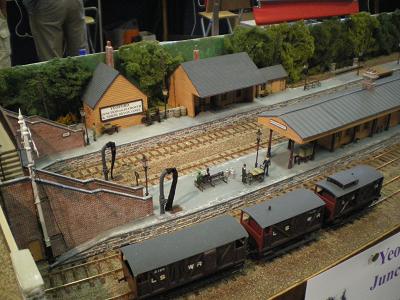Yeoford ![]()
John Nicholas EM gauge 4mm scale
Yeoford, 11 miles west of Exeter, was the junction station for the LSWR lines to Plymouth and North Devon, the actual divergence being a mile to the west at Coleford Junction signal box. The wide arches of the stone over-bridges and wide spacing of the platforms were inherited from the broad gauge North Devon Railwayj. The LSWR extended the station as part of its double track main line between Waterloo and Plymouth, adding up and down bay platforms together with a small marshalling yard on the down side.
During our chosen Edwardian period, we operate a timetable to include a sample of the more than 60 daily trains, including local passenger and goods trains from Exeter together with passenger trains or through coaches from Waterloo and goods trains from Nine Elms, together with stone trains from Meldon Quarry and coal from Fremington Quay. The Exeter and Torrington Travelling Post Office also runsj. Some slower trains are shunted into sidings to allow faster trains to overtake, with connections being made. As advised on the station nameboards, passengers travelling between stations on the North Devon and Plymouth lines alighted from trains on the up platform, crossed the footbridge and awaited a down train, making use of the refreshment room if time permitted. Luggage and parcels were transferred by trolley over the foot crossing. Mainly Adams and Drummond locomotives haul period trains, passengers being carried mainly in non-corridor stock but some new corridor coaches do appear.
All the essential features of the curved Yeoford Junction layout are incorporated, although the length has been reduced, mainly in the sidings. Two extra bridges have been incorporated to get trains 'off-stage' behind the sidings. All bridges and buildings are hand-built, based on the North Devon and South Western structures at Yeoford. Track is hand-built using EMGS components, most rolling stock is built from kits with some scratch-built and the locomotives are powered by Portescap motors.

